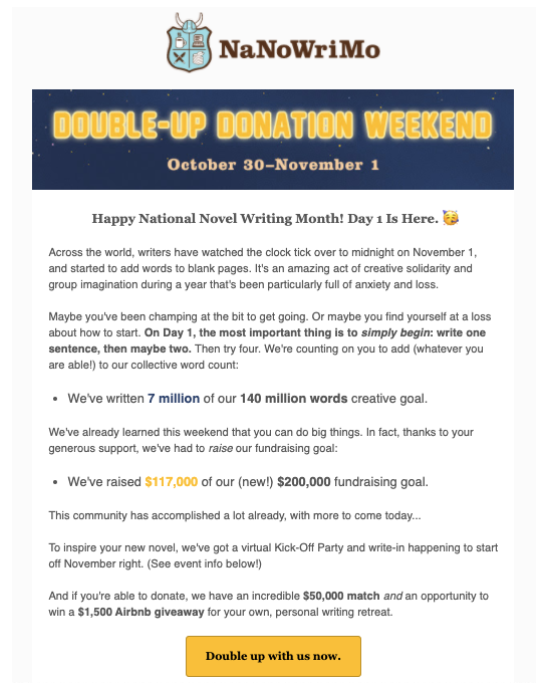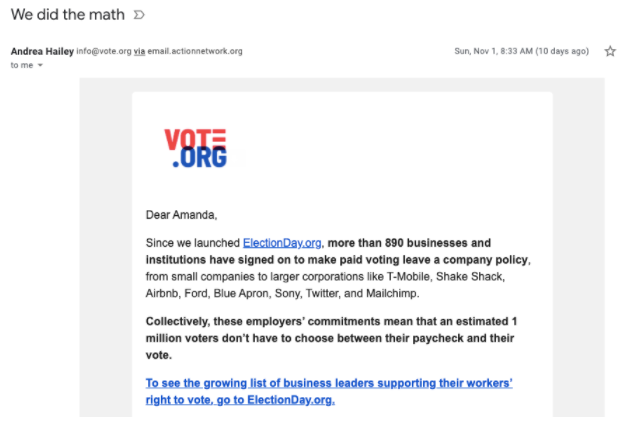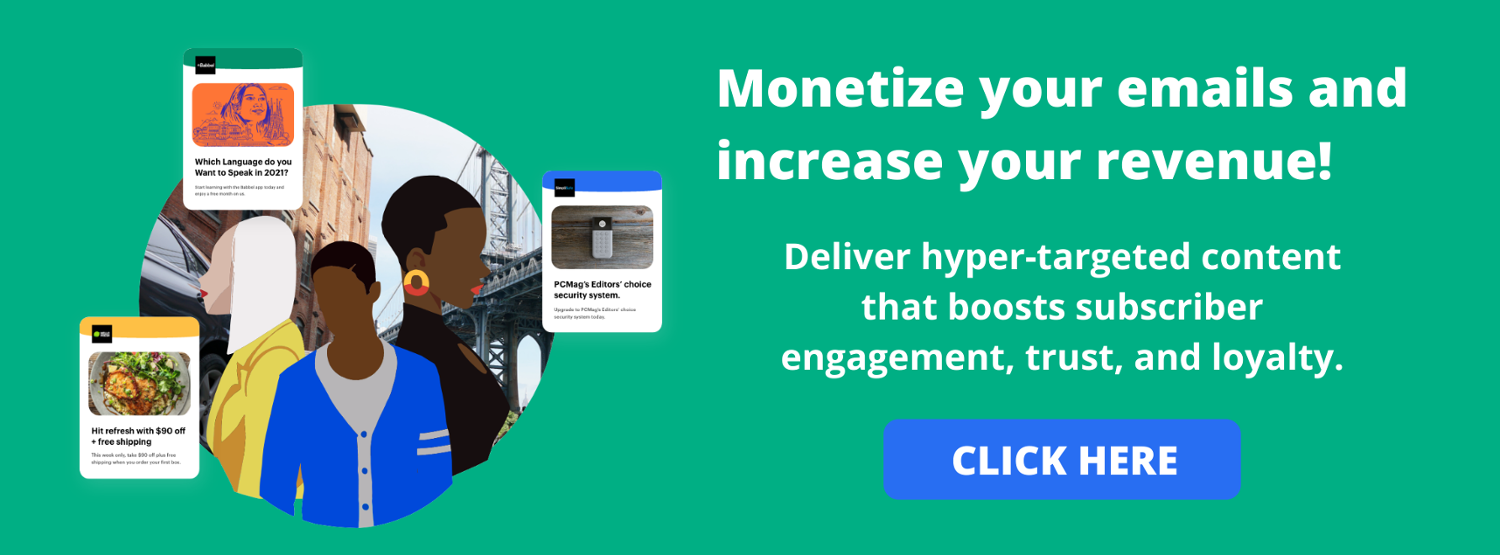Just like any other business, nonprofit organizations need clear marketing strategies that inspire audiences and align with their objectives. For most nonprofits, that #1 objective is to get more donations flowing in so they can deliver the services they value and promise. Email marketing for nonprofits is the key to achieving that goal.
Organizations in the social sector commonly have tight advertising budgets, so their marketing strategies can be somewhat limited.
The good news? They have an affordable and efficient solution in email marketing.
Email campaigns are fantastic for attracting and retaining donors, volunteers, and partners. On top of that, emails can also be monetized — essentially driving an additional stream of engagement and revenue.
That’s why we’re sharing exactly what nonprofit organizations need to know to make the most of their email marketing strategies — whether they’re starting from scratch or optimizing an existing operation for better results.
Let’s take a look.
TL;DR – watch this video:
Why email marketing for nonprofits is important
Email marketing is essential to nonprofit growth and audience outreach. Just look at the numbers. According to the 2020 Global Trends in Giving Report, donors across the world say email is the communication tool that most inspires them to give — more than print, social media, websites, and TV ads.
Almost half of donors also say regular email communication is the outreach method most likely to inspire repeat donations. On top of that, nonprofit emails drive better open rates than others: 25%, compared to the industry average of 21%, proving that nonprofit audiences are readily engaged and eager to consume your content.
Let’s get even more specific. Nonprofit organizations can use email to achieve key goals, such as:
- Driving donations. Since email reaches each reader directly, it’s the perfect medium for inspiring new and loyal donors to make an impact and spread the word to their own networks. For example, nonprofits can use email to launch and manage crowdfunding campaigns, interactive contests, and online fundraising events, such as conferences and auctions.
- Educating supporters. Nonprofits can use email to send important information about new programming, statistics in their field, and success stories from their services. They can also personalize emails by sharing customized updates for different tiers of donors or sending trending blog posts across unique interest categories.
- Building a loyal audience. You don’t want donors to be one-hit wonders. You want to nurture your relationships with them so they can continue providing support and, hopefully, further donations. That’s why nonprofits should use email to keep engaging donors and sharing important information about the causes that matter most to them.
Types of emails nonprofits should be sending
Email is completely customizable to your needs. Whether you want to send donors back to your website, offer quick program updates, highlight an inspiring story, or promote an upcoming event, you can do it through email.
Diving in further, here are some of the best email templates and types for nonprofit marketing.
Call-to-action for donations
You need support, and you shouldn’t be afraid to ask for it. Use email to get creative in your calls for funding and donations by sending relevant updates weekly, monthly, and/or quarterly.
NaNoWriMo, the nonprofit behind National Novel Writing Month, sent a round of emails reminding subscribers about its “double-up donation weekend,” when partner companies match donor contributions and offer up special prizes.
This email, for example, highlights the QBCPS Charitable Fund’s $50,000 match and how each donor is qualified to win Airbnb’s grand prize of a $1,500 credit. Weekend-long donation specials also invite donors to receive exclusive NaNoWriMo merchandise in exchange for $25 and $50 contributions.

Readers can join in and do their part by clicking the “Double up with us now” call-to-action button.
Special event promotion
Promote a special event where donors can connect with each other, hear from expert speakers, and learn more about your cause.
Just look at this email from Pencils of Promise, a nonprofit that builds schools and creates educational programs around the world. The email invites subscribers to register for the nonprofit’s first-ever virtual gala featuring honorees and special guests.

Scrolling down further, readers can click a big “Buy Ticket Now” call-to-action button to register, donate, and learn more about the occasion.
Inspiring success story
Share an inspiring story to help readers feel connected to your organization and overall mission.
Vote.org, for instance, launched this email highlighting the number of businesses that have signed up to make paid voting leave a company policy. The email also points readers to their website where they can learn more and donate to help continue driving results.

This email also illustrates how simple subject lines can sometimes be the most captivating. Vote.org didn’t write, “Look at what we’ve accomplished!” or “See how many businesses have signed up.” Instead, they stuck with a pared down teaser — “We did the math” — to pique readers’ interest and entice them to open the email.
3 tips for optimizing your nonprofit email marketing strategy
With the basics of email marketing for nonprofits under your belt, let’s take a look at more advanced best practices for engaging new audiences and driving revenue through email.
1. Monetize your email campaigns
So just how would a nonprofit monetize an email marketing campaign? There are many options to consider, but the first and easiest is with an integrated native ad. An advertisement that’s smoothly folded into your existing email template in an organic way. It is an easy way to engage your audience while still promoting a product or service. These advertisements take a form of suggested reading content and are a great way to make money without alienating your subscriber base.
Take the Aircraft Owners and Pilots Association (AOPA), for example. Run by the nonprofit AOPA Foundation, this organization brings together over 300,000 pilots and aviation enthusiasts through a suite of media properties. Included in there is a series of nine email newsletters. To increase revenue, the AOPA monetizes six of those email newsletters with several ad units.
Ads are personalized by circulation base, content category, and region, so the AOPA knows they’re reaching only those most likely to engage. Ads are also distributed programmatically, meaning multiple ads can rotate through one ad slot based on each subscriber’s interests and behaviors — increasing clicks and revenue.
2. Create compelling calls to action
The advantage of an email list over social media is in its targeted nature. Nonprofits’ lists should be mostly, if not completely, comprised of people who have supported the organization in the past or at least are familiar with its mission and interested in spreading awareness. Nonprofits who have an active fundraising campaign can insert a “Donate” button to route people directly to the active campaign, or, can have a contest to encourage people to share the campaign on social media.
3. Inspire through storytelling
No matter the type of campaign that is being sent, regular email newsletters is an important way to leverage the power of storytelling. By regularly engaging with email subscribers in this way, nonprofits can build an emotional connection, which will catalyze people to take action—whether via donation or campaign sharing. Nonprofit organizations should be sure to remain creative and fresh in the ways that they tell their story. Video, on-the-open Instagram photos, and highly clicked blog content are all ways to keep the approach fresh.
For nonprofits, email is a given
When it comes to marketing, nonprofits have to wear many hats. They have to be publishers of inspiring stories, advertisers of lifesaving services, educators of complex information, community builders for people who share similar values… the list goes on.
There’s only one channel that’s tailor-made for all of these roles: email.
Email is a channel of the people. Each message reaches each user directly in their own, private inbox. And it’s opt-in, so you know you’re reaching audiences who’ve proactively chosen to hear from you.
That’s why, email marketing for nonprofits should be a given — providing a way to build audiences, deliver valuable data, drive donations, and increase revenue through personalized ads.
You just need the right email marketing tools to help.
Take Jeeng, the platform built to drive multichannel, personalized subscriber engagement. We help you advertise across our premium publisher network and monetize your emails, so you can increase revenue via the most valuable channels on the web.
Ready to drive more income and engagement for your nonprofit? Contact us today.




